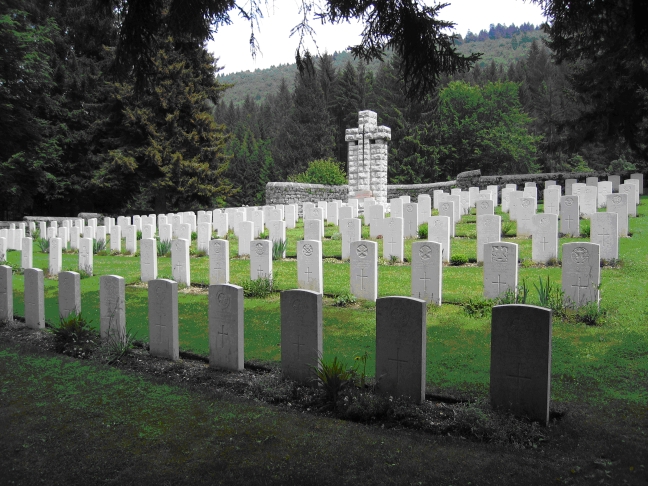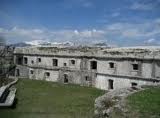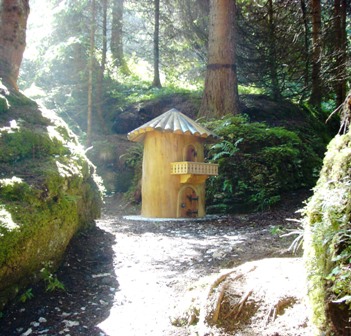 THE ENGLISH CEMETERIES
THE ENGLISH CEMETERIES
On the plateau there are five English cemeteries managed by the "Commonwealth War Graves Commission": Barenthal, Granezza, Cavalletto, Magnaboschi, Boscon.

THE ASTRONOMICAL OBSERVATORY
It is the most important centre for astronomic research in Italy. It is 2 km from the centre of Asiago in the direction of Pennar. It has a separate site on Cima Eckar where the largest telescope in Italy, and one of the largest in Europe, can be found. For further information
click on the link Osservatorio di Asiago
 CORBIN FORT AND PLACES OF THE GREAT WAR
CORBIN FORT AND PLACES OF THE GREAT WAR
A work of engineering built on the plateau in the period leading up to the outbreak of the First World War. Indeed, it was started in 1906 and is currently an excellent example of a typical First World War fort on high ground. It was built on a jutted cliff so as to close the valley below. The intricate and refined structure that is still highly visible are an excellent example of what the period’s military engineering could create. A year after the beginning of the conflict, the lack of medium calibres in the advanced area meant that some of Fort Corbin’s best pieces were removed, to the extent that tree trunks were set up in the domes to make the enemy believe that the fort was fully functional. On the 15th May 1916 large shells (first 380mm and then 480mm) fell on the Fort. Following a period in the hands of the Austrians, after the Strafexpedition, for several years the Fort was used for military training living quarters. The State then sold it to its current owner, Severino Panozzo. The fort is already an established tourist attraction and this year it has something new to offer: solar panel lighting of the two powder deposits, both well preserved, the work of the owner’s eighteen year old son, Federico Panozzo. At night a multi-colour light, clearly visible from the Arsiero area, lights up the Corbin Fort. To get to the Fort, from the parish church of Tresche Conca, follow the road towards Malga Rocchetto for 5-6kms.
THE HISTORY OF THE PIOVENE-ROCCHETTE/ASIAGO RAILWAY LINE
Up to the middle of the 19th century, the tableland of the seven municipalities was only linked to the valley by a cart track that made its way up to Cogollo del Cengio and by three stairways: the Calà del Sasso (4444 steps), the Piovega di Sopra (4480) and the Piovega di Sotto (5680), which acted as links with the Valsugana, Enego and Primolano.
To overcome the lack of adequate links with the valley, obliging the tableland to put up with counter-productive isolation, especially in the winter, in 1882 the wool industrialist, Alessandro Rossi proposed a rail link with the valley, charging the engineer Alfonso Crippa the with task of giving concrete form to the idea.
The first project (Arsiero via Pedelasca, Castelletto, Roana, Canove and arrival in Asiago after 32.35 km of track) was abandoned because of the length of the route and the high cost of the work.
Alessandro Rossi then called on the engineer Ferdinando Shacke, an export in mountain railways, who presented the project for the Piovene-Rocchette/Asiago line, 21.19 km long, with 5.76 km of cog railway track. The project was approved on 15/07/1907 and work began immediately afterwards.
On 10/01/1910 the line was officially inaugurated, thus ending the long isolation of the tableland. A fundamental role was played by the train during the two world wars, as it allowed troops and arms to be transported, but also the moving of evacuees.
In 1958 the definitive closure of the railway service was decreed, due to high management costs and competition from the "SITA" bus service. Subsequently, the whole track was dismantled and the locomotives were demolished; only the level-crossing lodges and the stations remained standing, with the exception of Cesuna station, which was knocked down.After 48 years this was thus the end of a praiseworthy service of very high social value, managed with skill and sacrifice by all staff of the railway.

It is a magic place situated int the wonderful park of about 90.000 square metres of the Hotel Da Barba.In a pure environment and enchanting atmosphere, there is a path among the spruce forests and pastures.While walking one can meet a small lake, a wooden bridge, little houses among the trees, short falls of water and ...maybe a gnome!







